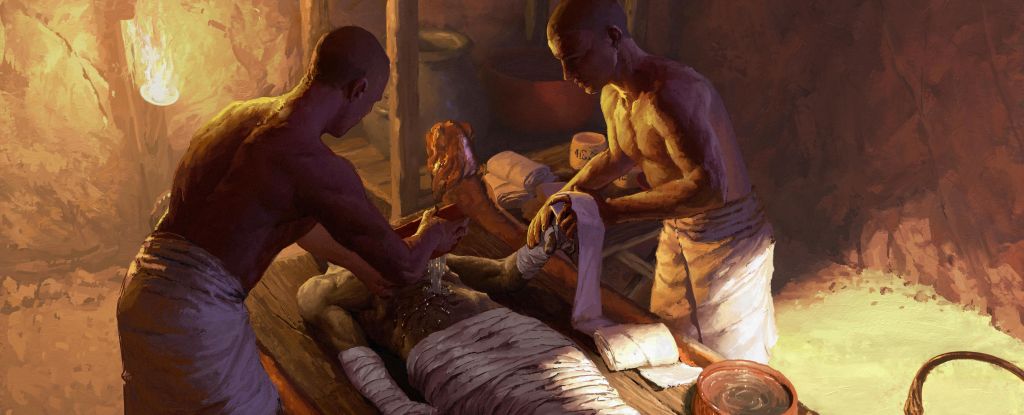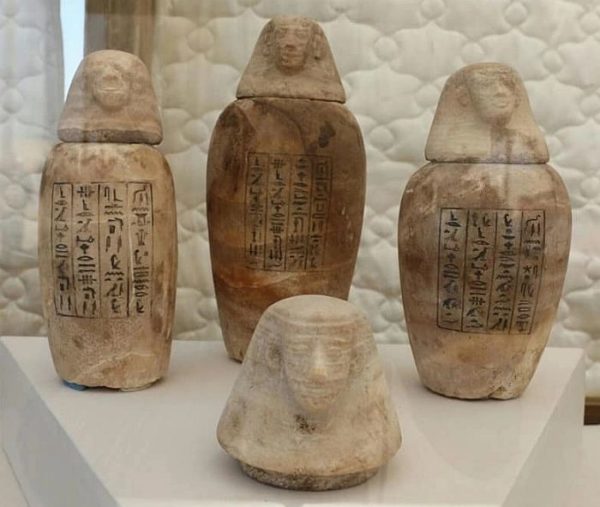
Posted on 02/01/2023 9:42:21 AM PST by Red Badger

An illustration depicting the ancient Egyptian process of embalming. (Nikola Nevenov)
*********************************************************
An analysis of the residue on ceramics found in an ancient embalming workshop has given us new insights into how ancient Egyptians mummified their dead.
Even more astonishingly, a team of scientists has been able to link different substances to the specific parts of the body on which they were used.
This discovery is, in part, thanks to the residues themselves, which were studied using biomolecular techniques; but many of the vessels were intact, including not just the names of their contents, but instructions for their use.
"We have known the names of many of these embalming ingredients since ancient Egyptian writings were deciphered," says archaeologist Susanne Beck of the University of Tübingen in Germany in a statement provided to the press.
"But until now, we could only guess at what substances were behind each name."
The workshop was part of an entire burial complex in Saqqara, Egypt, that was discovered by a joint German-Egyptian team in 2018, dating back to the 26th or Saite Dynasty, between 664–525 BCE.
The grave goods recovered were spectacular, including mummies, canopic jars containing their organs, and ushabti figurines, to serve the dead in their afterlife.

Alabaster canopic jars recovered from Saite-Saqqara. (Egyptian Ministry of Antiquities)
And there was the workshop, filled with ceramic jars, measuring cups, and bowls, neatly labeled according to their contents or use.
Led by archaeologist Maxime Rageot of the University of Tübingen, the researchers conducted a thorough examination of 31 of these vessels, using gas chromatography-mass spectrometry to determine the ingredients of the embalming materials therein.
The detailed results are fascinating, and in some cases, completely unexpected.
"The substance labeled by the ancient Egyptians as antiu has long been translated as myrrh or frankincense. But we have now been able to show that it is actually a mixture of widely differing ingredients," Rageot explains in the statement.
These ingredients were cedar oil, juniper or cypress oil, and animal fat, the team found, although the mixture may vary from place to place and time to time.
The team also compared instructions inscribed on some of the vessels to their contents to determine how each mixture was used. Instructions included "to put on his head", "bandage or embalm with it", and "to make his odor pleasant".
Eight different vessels had instructions regarding the treatment of the deceased's head; pistachio resin and castor oil were two ingredients that only appeared in these vessels, often in a mixture that contained other elements, such as elemi resin, plant oil, beeswax, and tree oils.

Some of the vessels found in the embalming workshop. (Saqqara Saite Tombs Project, University of Tübingen; M. Abdelghaffar)
Animal fat and Burseraceae resin were used to deal with the smell of the decomposing body, and animal fat and beeswax were used to treat the skin on the third day of treatment. Tree oils or tars, along with plant oil or animal fat, could be used to treat the bandages used to wrap the mummy, as found in eight more vessels.
Even more fascinating is what these mixtures can reveal about global trade at the time.
Pistachio, cedar oil, and bitumen were probably all sourced from the Levant on the Eastern shore of the Mediterranean.
However, elemi and another resin called dammar come from much farther away: Elemi grows in both sub-Saharan Africa and Southeast Asia, but the tree that produces dammar only grows in Southeast Asia.
Therefore, it's possible that these two resins traveled the same trade route to Egypt, the researchers note in their paper, suggesting that a great deal of effort went into sourcing the specific ingredients used for embalming. This possibly played a significant role in the establishment of global trade networks.
Meanwhile, the team's work on the 121 bowls and cups recovered from the workshop will continue.
"Thanks to all the inscriptions on the vessels, we will in future be able to further decipher the vocabulary of ancient Egyptian chemistry that we did not sufficiently understand to date," says archaeologist Philipp Stockhammer of Ludwig Maximilian University of Munich in Germany in the statement.
The excavation of the tomb complex was led by archaeologist Ramadan Hussein of the University of Tübingen, who sadly passed away last year, before the work could be completed.
The research has been published in Nature.
PinGGG!........................
Medicated Goo
https://www.youtube.com/watch?v=TtldbDwAk9E
turns out
it is the kfc 11 herbs and spices
Finger lickin’ good!........................or any other parts that are left over....................
Did the Ancient Egyptian EPA have ancient containment booms for their goo spills?

Man it feels like I’ve been asleep for centuries! All I have to do now is find my liver, pancreas, and my wallet and I’m ready to trek into town.
So, it was the ancient Egyptians, and not Phil Swift, who invented Flex Seal.
“he tree that produces dammar only grows in Southeast Asia...”
Gee, it’s almost like Egypt is just a leisurely coastal voyage away from India...
I wonder how ancient goo stacks up against modern goo.
The two who were embalmed (preserved) in Egypt:
The beginning and end of Genesis 50, the last chapter of Genesis:
1 And Joseph fell upon his father's face, and wept upon him, and kissed him.
2 And Joseph commanded his servants the physicians to embalm his father: and the physicians embalmed Israel.
3 And forty days were fulfilled for him; for so are fulfilled the days of those which are embalmed: and the Egyptians mourned for him threescore and ten days.
>>>
24 And Joseph said unto his brethren, I die: and God will surely visit you, and bring you out of this land unto the land which he sware to Abraham, to Isaac, and to Jacob.
25 And Joseph took an oath of the children of Israel, saying, God will surely visit you, and ye shall carry up my bones from hence.
26 So Joseph died, being an hundred and ten years old: and they embalmed him, and he was put in a coffin [אָרוֹן] in Egypt.
***
As we have already seen, early on Joseph is linked to the fulfillment of Jacob's legacy.
These are the generations of Jacob, Joseph was seventeen years old ...[Genesis 37:2]
At the outset, the Torah connects Jacob with Joseph. Of all his sons specifically Joseph holds the key to not only Jacob's but the family's ission.
Joseph From the Kabbalistic Perspective
key: ☥
The real Joseph & Sons -- on a mission to save life by a great deliverance.
[מיין] =
40 [מ] + 70 [יין]
= 110
he tree that produces dammar only grows in Southeast Asia.
—
And how did they know dammar was there and what it could be used for?
The Internet of course!.................It was kinda slow back then.................

There’s a lot of money in the burial business.
Very interesting, however, I think I’ll just stick with Tito’s.
Thanks Red Badger.
MODERN GOO.............
Hi.
Now I read about that goo. Damn. I was in Luxor and this Egyptian tried to sell me some of that stuff.
I asked him what’s it for, and he said cooking.
I should have brought some.
5.56mm
Disclaimer: Opinions posted on Free Republic are those of the individual posters and do not necessarily represent the opinion of Free Republic or its management. All materials posted herein are protected by copyright law and the exemption for fair use of copyrighted works.